| Solar eclipse of July 28, 1851 | |
|---|---|
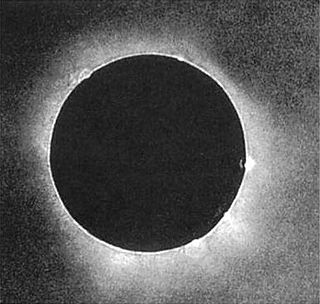 Berkowski made this first solar eclipse photograph at the Royal Observatory in Königsberg, Prussia (now Kaliningrad, Russia) | |
| Type of eclipse | |
| Nature | Total |
| Gamma | 0.7644 |
| Magnitude | 1.0577 |
| Maximum eclipse | |
| Duration | 221 s (3 min 41 s) |
| Coordinates | 68°00′N 19°36′W / 68°N 19.6°W |
| Max. width of band | 296 km (184 mi) |
| Times (UTC) | |
| Greatest eclipse | 14:33:42 |
| References | |
| Saros | 143 (14 of 72) |
| Catalog # (SE5000) | 9167 |
A total solar eclipse occurred at the Moon's ascending node of orbit on Monday, July 28, 1851, with a magnitude of 1.0577. A solar eclipse occurs when the Moon passes between Earth and the Sun, thereby totally or partly obscuring the image of the Sun for a viewer on Earth. A total solar eclipse occurs when the Moon's apparent diameter is larger than the Sun's, blocking all direct sunlight, turning day into darkness. Totality occurs in a narrow path across Earth's surface, with the partial solar eclipse visible over a surrounding region thousands of kilometres wide. Occurring about 1.5 days before perigee (on July 30, 1851, at 2:30 UTC), the Moon's apparent diameter was larger.[1]
The path of totality was visible from parts of modern-day Canada, Greenland, Iceland, Norway, Sweden, Denmark, Poland, Russia, southwestern Lithuania, Belarus, Ukraine, Moldova, Georgia, Armenia, and Azerbaijan. A partial solar eclipse was also visible for parts of North America, Europe, North Africa, Russia, the Middle East, and Central Asia.
This was the earliest scientifically useful photograph of a total solar eclipse, made by Julius Berkowski at the Royal Observatory in Königsberg, Prussia. It was the first occasion that an accurate photographic image of a solar eclipse was recorded.
Background
[edit]A solar eclipse occurs when the Moon passes between the Earth and the Sun, casting a shadow on Earth that temporarily obscures part or all of the Sun's disc. Eclipses can occur only when all three bodies are properly aligned. Partial eclipses, in which only a portion of the Sun's surface is obscured, are relatively common due to the width of the Moon's outer shadow, or penumbra, which may be several hundred miles wide. Total eclipses occur when the Moon's inner shadow, or umbra, reaches the surface of the Earth, completely obscuring the Sun over a much narrower portion of the ground. If the Moon is too far away at the time of an eclipse, its umbra may not reach the Earth's surface, and only a partial eclipse will be visible.
Before the advent of modern science, solar eclipses were often viewed with superstitious dread. However, eclipses are also of interest to science due to the various phenomena that can be observed when they occur. The Sun's outer atmosphere, or corona, is normally invisible due to the brightness of the solar disc, but becomes visible from Earth during a total eclipse. Until the twentieth century, solar eclipses provided the only opportunity for scientists to observe and study the Sun's corona. With the development of photography during the first half of the nineteenth century, it became theoretically possible to record a still image of the Sun during a total eclipse. A variety of processes were used for early photographs, of which the most successful was the daguerreotype.
Monday, July 28, 1851
[edit]
Photographing a rare event such as a total eclipse posed unique challenges for early photography, including the extreme contrast between the corona and the dark shadow of the Moon, as well as the unusual angle to which photographic equipment had to be oriented. Prior to the eclipse of July 28, 1851, no properly exposed photograph of the solar corona had yet been produced. For this occasion, the Royal Prussian Observatory at Königsberg (now Kaliningrad, Russia) commissioned one of the city's most skilled daguerreotypists, Johann Julius Friedrich Berkowski, to record a still image of the event.[2] The observers attached a small six-centimeter refracting telescope to a 15.8 centimeter Fraunhofer heliometer, and Berkowski made an eighty-four second exposure shortly after the beginning of totality.[3]
Among the other observers were British astronomers Robert Grant and William Swan, and Austrian astronomer Karl Ludwig von Littrow. They deduced that prominences were part of the Sun, because the Moon was seen to cover and uncover them as it moved in front of the Sun.[4][better source needed]
-
From Gdańsk
-
Partial from Shelbyville, Kentucky
Eclipse details
[edit]Shown below are two tables displaying details about this particular solar eclipse. The first table outlines times at which the moon's penumbra or umbra attains the specific parameter, and the second table describes various other parameters pertaining to this eclipse.[5]
| Event | Time (UTC) |
|---|---|
| First Penumbral External Contact | 1851 July 28 at 12:15:06.1 UTC |
| First Umbral External Contact | 1851 July 28 at 13:24:53.6 UTC |
| First Central Line | 1851 July 28 at 13:26:48.7 UTC |
| First Umbral Internal Contact | 1851 July 28 at 13:28:45.8 UTC |
| Equatorial Conjunction | 1851 July 28 at 14:21:59.0 UTC |
| Greatest Eclipse | 1851 July 28 at 14:33:41.9 UTC |
| Greatest Duration | 1851 July 28 at 14:33:48.3 UTC |
| Ecliptic Conjunction | 1851 July 28 at 14:41:27.8 UTC |
| Last Umbral Internal Contact | 1851 July 28 at 15:38:44.7 UTC |
| Last Central Line | 1851 July 28 at 15:40:43.2 UTC |
| Last Umbral External Contact | 1851 July 28 at 15:42:39.8 UTC |
| Last Penumbral External Contact | 1851 July 28 at 16:52:19.9 UTC |
| Parameter | Value |
|---|---|
| Eclipse Magnitude | 1.05765 |
| Eclipse Obscuration | 1.11863 |
| Gamma | 0.76436 |
| Sun Right Ascension | 08h28m49.7s |
| Sun Declination | +19°03'55.7" |
| Sun Semi-Diameter | 15'45.2" |
| Sun Equatorial Horizontal Parallax | 08.7" |
| Moon Right Ascension | 08h29m18.2s |
| Moon Declination | +19°49'34.3" |
| Moon Semi-Diameter | 16'29.2" |
| Moon Equatorial Horizontal Parallax | 1°00'30.3" |
| ΔT | 7.1 s |
Eclipse season
[edit]This eclipse is part of an eclipse season, a period, roughly every six months, when eclipses occur. Only two (or occasionally three) eclipse seasons occur each year, and each season lasts about 35 days and repeats just short of six months (173 days) later; thus two full eclipse seasons always occur each year. Either two or three eclipses happen each eclipse season. In the sequence below, each eclipse is separated by a fortnight.
| July 13 Descending node (full moon) |
July 28 Ascending node (new moon) |
|---|---|

| |
| Partial lunar eclipse Lunar Saros 117 |
Total solar eclipse Solar Saros 143 |
Related eclipses
[edit]Eclipses in 1851
[edit]- A partial lunar eclipse on January 17.
- An annular solar eclipse on February 1.
- A partial lunar eclipse on July 13.
- A total solar eclipse on July 28.
Metonic
[edit]- Preceded by: Solar eclipse of October 9, 1847
- Followed by: Solar eclipse of May 16, 1855
Tzolkinex
[edit]- Preceded by: Solar eclipse of June 16, 1844
- Followed by: Solar eclipse of September 7, 1858
Half-Saros
[edit]- Preceded by: Lunar eclipse of July 22, 1842
- Followed by: Lunar eclipse of August 1, 1860
Tritos
[edit]- Preceded by: Solar eclipse of August 27, 1840
- Followed by: Solar eclipse of June 27, 1862
Solar Saros 143
[edit]- Preceded by: Solar eclipse of July 17, 1833
- Followed by: Solar eclipse of August 7, 1869
Inex
[edit]- Preceded by: Solar eclipse of August 16, 1822
- Followed by: Solar eclipse of July 7, 1880
Triad
[edit]- Preceded by: Solar eclipse of September 25, 1764
- Followed by: Solar eclipse of May 29, 1938
Solar eclipses of 1848–1852
[edit]This eclipse is a member of a semester series. An eclipse in a semester series of solar eclipses repeats approximately every 177 days and 4 hours (a semester) at alternating nodes of the Moon's orbit.[6]
The partial solar eclipses on April 3, 1848 and September 27, 1848 occur in the previous lunar year eclipse set, and the solar eclipses on June 17, 1852 (partial) and December 11, 1852 (total) occur in the next lunar year eclipse set.
| Solar eclipse series sets from 1848 to 1852 | ||||||
|---|---|---|---|---|---|---|
| Descending node | Ascending node | |||||
| Saros | Map | Gamma | Saros | Map | Gamma | |
| 108 | March 5, 1848 Partial |
1.3950 | 113 | August 28, 1848 Partial |
−1.5475 | |
| 118 | February 23, 1849 Annular |
0.7475 | 123 | August 18, 1849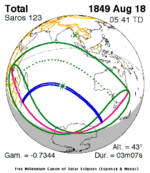 Total |
−0.7343 | |
| 128 | February 12, 1850 Annular |
0.0503 | 133 | August 7, 1850 Total |
0.0215 | |
| 138 | February 1, 1851 Annular |
−0.6413 | 143 | July 28, 1851 Total |
0.7644 | |
| 148 | January 21, 1852 Partial |
−1.2948 | ||||
Saros 143
[edit]This eclipse is a part of Saros series 143, repeating every 18 years, 11 days, and containing 72 events. The series started with a partial solar eclipse on March 7, 1617. It contains total eclipses from June 24, 1797 through October 24, 1995; hybrid eclipses from November 3, 2013 through December 6, 2067; and annular eclipses from December 16, 2085 through September 16, 2536. The series ends at member 72 as a partial eclipse on April 23, 2897. Its eclipses are tabulated in three columns; every third eclipse in the same column is one exeligmos apart, so they all cast shadows over approximately the same parts of the Earth.
The longest duration of totality was produced by member 16 at 3 minutes, 50 seconds on August 19, 1887, and the longest duration of annularity will be produced by member 51 at 4 minutes, 54 seconds on September 6, 2518. All eclipses in this series occur at the Moon’s ascending node of orbit.[7]
| Series members 12–33 occur between 1801 and 2200: | ||
|---|---|---|
| 12 | 13 | 14 |
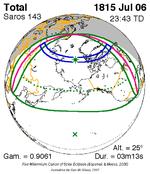 July 6, 1815 |
 July 17, 1833 |
 July 28, 1851 |
| 15 | 16 | 17 |
 August 7, 1869 |
 August 19, 1887 |
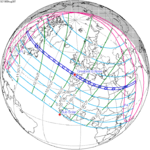 August 30, 1905 |
| 18 | 19 | 20 |
 September 10, 1923 |
 September 21, 1941 |
 October 2, 1959 |
| 21 | 22 | 23 |
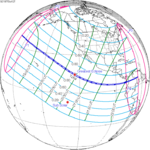 October 12, 1977 |
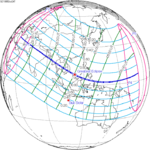 October 24, 1995 |
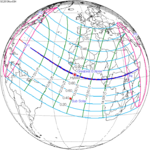 November 3, 2013 |
| 24 | 25 | 26 |
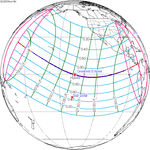 November 14, 2031 |
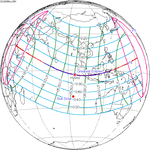 November 25, 2049 |
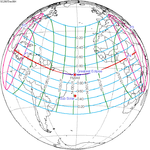 December 6, 2067 |
| 27 | 28 | 29 |
 December 16, 2085 |
 December 29, 2103 |
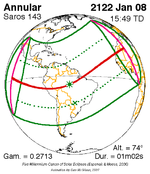 January 8, 2122 |
| 30 | 31 | 32 |
 January 20, 2140 |
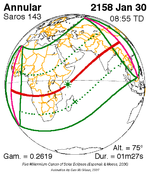 January 30, 2158 |
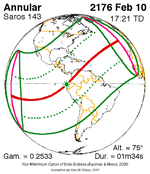 February 10, 2176 |
| 33 | ||
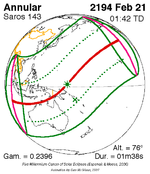 February 21, 2194 | ||
Metonic series
[edit]The metonic series repeats eclipses every 19 years (6939.69 days), lasting about 5 cycles. Eclipses occur in nearly the same calendar date. In addition, the octon subseries repeats 1/5 of that or every 3.8 years (1387.94 days). All eclipses in this table occur at the Moon's descending node.
| 24 eclipse events between March 4, 1802 and July 28, 1870 | ||||
|---|---|---|---|---|
| March 4 | December 20–21 | October 8–9 | July 27–28 | May 15–16 |
| 117 | 119 | 121 | 123 | 125 |
 March 4, 1802 |
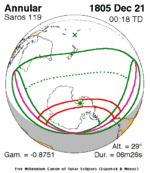 December 21, 1805 |
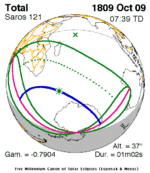 October 9, 1809 |
 July 27, 1813 |
 May 16, 1817 |
| 127 | 129 | 131 | 133 | 135 |
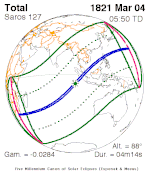 March 4, 1821 |
 December 20, 1824 |
 October 9, 1828 |
 July 27, 1832 |
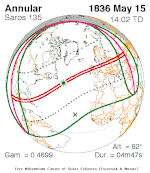 May 15, 1836 |
| 137 | 139 | 141 | 143 | 145 |
 March 4, 1840 |
 December 21, 1843 |
 October 9, 1847 |
 July 28, 1851 |
 May 16, 1855 |
| 147 | 149 | 151 | 153 | |
 March 4, 1859 |
 December 21, 1862 |
 October 8, 1866 |
 July 28, 1870 | |
Tritos series
[edit]This eclipse is a part of a tritos cycle, repeating at alternating nodes every 135 synodic months (≈ 3986.63 days, or 11 years minus 1 month). Their appearance and longitude are irregular due to a lack of synchronization with the anomalistic month (period of perigee), but groupings of 3 tritos cycles (≈ 33 years minus 3 months) come close (≈ 434.044 anomalistic months), so eclipses are similar in these groupings.
| Series members between 1801 and 1982 | ||||
|---|---|---|---|---|
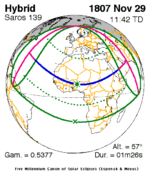 November 29, 1807 (Saros 139) |
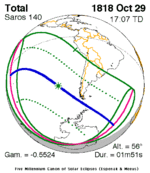 October 29, 1818 (Saros 140) |
 September 28, 1829 (Saros 141) |
 August 27, 1840 (Saros 142) |
 July 28, 1851 (Saros 143) |
 June 27, 1862 (Saros 144) |
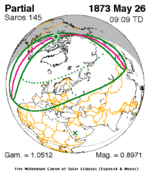 May 26, 1873 (Saros 145) |
 April 25, 1884 (Saros 146) |
 March 26, 1895 (Saros 147) |
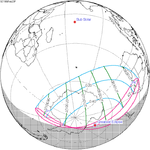 February 23, 1906 (Saros 148) |
 January 23, 1917 (Saros 149) |
 December 24, 1927 (Saros 150) |
 November 21, 1938 (Saros 151) |
 October 21, 1949 (Saros 152) |
 September 20, 1960 (Saros 153) |
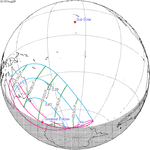 August 20, 1971 (Saros 154) |
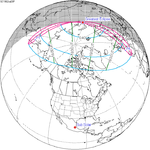 July 20, 1982 (Saros 155) | |||
Inex series
[edit]This eclipse is a part of the long period inex cycle, repeating at alternating nodes, every 358 synodic months (≈ 10,571.95 days, or 29 years minus 20 days). Their appearance and longitude are irregular due to a lack of synchronization with the anomalistic month (period of perigee). However, groupings of 3 inex cycles (≈ 87 years minus 2 months) comes close (≈ 1,151.02 anomalistic months), so eclipses are similar in these groupings.
| Series members between 1801 and 2200 | ||
|---|---|---|
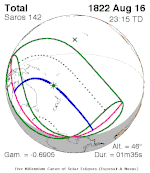 August 16, 1822 (Saros 142) |
 July 28, 1851 (Saros 143) |
 July 7, 1880 (Saros 144) |
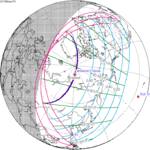 June 17, 1909 (Saros 145) |
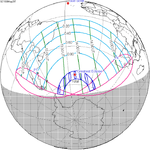 May 29, 1938 (Saros 146) |
 May 9, 1967 (Saros 147) |
 April 17, 1996 (Saros 148) |
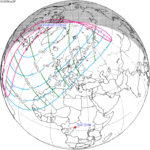 March 29, 2025 (Saros 149) |
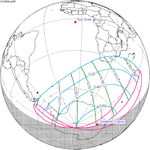 March 9, 2054 (Saros 150) |
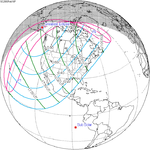 February 16, 2083 (Saros 151) |
 January 29, 2112 (Saros 152) |
 January 8, 2141 (Saros 153) |
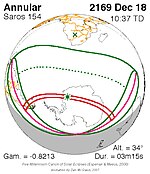 December 18, 2169 (Saros 154) |
 November 28, 2198 (Saros 155) |
|
References
[edit]- ^ "Moon Distances for London, United Kingdom, England". timeanddate. Retrieved 17 September 2024.
- ^ Axel D. Wittmann and Reinhard E. Schielicke (2013). "Richard und John Parish, Förderer der Astronomie zur Zeit von Gauß, und die Sonnenfinsternis–Daguerreotypie von Julius Berkowski (1851)" (PDF). University of Jena, Astrophysical Institute and University Observatory. Archived from the original (PDF) on 2015-04-02. Retrieved 2015-03-22.
- ^ Schielicke, Reinhard; Wittmann, Axel D. (2005). "On the Berkowski daguerreotype (Königsberg, 1851 July 28): the first correctly-exposed photograph of the solar corona". Acta Historica Astronomiae. 25: 128. Bibcode:2005AcHA...25..128S.
- ^ "Chronology of Discoveries about the Sun". www.mreclipse.com.
- ^ "Total Solar Eclipse of 1851 Jul 28". EclipseWise.com. Retrieved 17 September 2024.
- ^ van Gent, R.H. "Solar- and Lunar-Eclipse Predictions from Antiquity to the Present". A Catalogue of Eclipse Cycles. Utrecht University. Retrieved 6 October 2018.
- ^ "NASA - Catalog of Solar Eclipses of Saros 143". eclipse.gsfc.nasa.gov.
External links
[edit]- NASA chart graphics
- Axel D. Wittmann (2005). Development of Solar Research: Proceedings of the Colloquium, Freiburg (Breisgau), September 15, 2003. Deutsch. p. 128. ISBN 978-3-8171-1755-0.[permanent dead link]
- FIRST SUN PHOTO
- On the Berkowski Daguerreotype (Konigsberg, 1851 July 28): The First Correctly Exposed Eclipse Photograph of the Solar Corona
- From eclipse drawings to the coronagraph and spectroscopy
- History of Astrophotography Timeline
- Sketch of Solar Corona 1851 July 28
- Solar eclipse of July 28, 1851 in Russia Archived May 21, 2009, at the Wayback Machine





